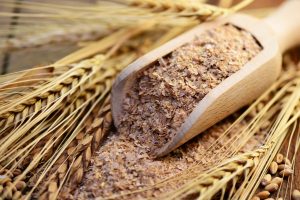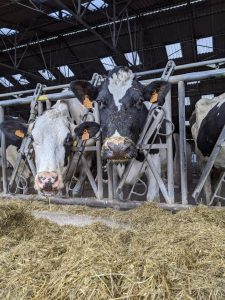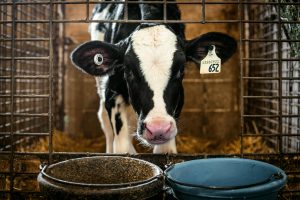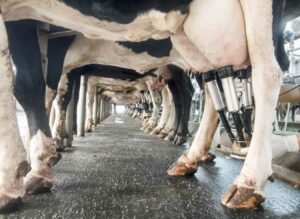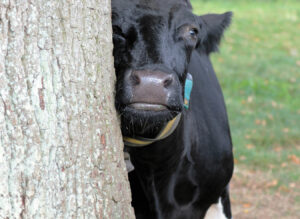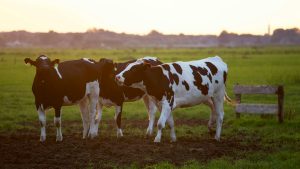Álvaro García
As the dairy industry faces increasing pressure to improve sustainability and reduce its environmental impact, one area of focus has been feed efficiency and its direct connection to methane production. Methane, a potent greenhouse gas, is a byproduct of enteric fermentation in ruminants. Understanding and modeling the relationship between feed intake and methane emissions has become an essential part of developing strategies to make dairy farming more efficient and environmentally friendly. In this article, we discuss the basics of modeling intake and methane production, highlighting how advanced genetic and management tools can help farmers reduce both costs and environmental footprints.
The Importance of Feed Intake in Dairy Farming
Feed intake is a critical component of dairy cow productivity. Cows must consume enough feed to support milk production, maintain body condition, and meet reproductive needs. However, the efficiency with which cows convert feed into milk varies widely, with some cows being more efficient than others at converting nutrients into milk production. This efficiency, known as feed efficiency (FE), is influenced by both genetic factors and management practices.
Feed intake not only impacts milk yield but also affects methane emissions. As cows digest their food, microbes in their digestive system (primarily reticulum-rumen, and colon-cecum) ferment the feed, producing methane as a byproduct. The more feed a cow consumes, the more methane it tends to produce, unless the cow is genetically predisposed to better feed conversion.
Understanding Methane Production in Dairy Cows
As such, methane production in ruminants is a natural process resulting from enteric fermentation of microbial breakdown of feed in the rumen. This process is essential for cows to digest fibrous plant materials like pasture, silage, and hay. However, during this fermentation process, methane is produced and released in greater proportion through belching.
The amount of methane produced varies depending on factors such as:
- Type and quality of feed: High-fiber diets tend to produce more methane.
- Feed intake levels: More feed leads to more methane.
- Animal genetics: Some cows produce less methane for the same amount of feed intake, thanks to genetic traits related to feed efficiency.
- Cow health and management: Health issues or poor feeding practices can exacerbate methane production.
Globally, methane is a significant contributor to climate change due to its high global warming potential. As a result, the agricultural sector, particularly the dairy industry, is under increasing scrutiny to develop ways to reduce methane emissions without sacrificing productivity.
Feed Intake and Methane Production
To address both feed efficiency and methane production, scientists and industry experts use mathematical models to simulate the relationship between intake, digestive processes, and methane emissions. These models rely on complex equations that incorporate various factors, including the cow’s feed type, intake level, and metabolic efficiency.
Some of the key components of these models include:
Feed Intake Estimates
Dry Matter Intake (DMI): This is the amount of feed that a cow consumes, adjusted for moisture content. It is the first critical input in estimating how much methane a cow will produce. Various management factors (such as feed type and quality, farm practices, and cow age) affect DMI. One such example is the work by Ellis et al. (2007) which used the following equation: Methane Emissions (g/day) = a + b x DMI (kg/day). Where:
a is the intercept, representing baseline emissions not directly tied to DMI.
b is the coefficient reflecting the rate of methane production per kilogram of DMI.
The model’s primary advantage lies in its simplicity, requiring only DMI as an input, making it easy to use in various management and research settings. While designed for broad application, it is most accurate for predicting methane emissions under average feeding conditions where diet composition and feeding practices do not vary significantly.
The main limitations are that first it does not account for differences in diet composition (e.g., forage-to-concentrate ratio) or feed digestibility, which significantly influence methane production. Secondly, the model may be less accurate for predicting methane emissions in high-producing cows or those fed diets with unusual feed types or additives designed to mitigate methane production.
Nevertheless, the Ellis et al. model provides a valuable baseline for understanding the relationship between DMI and methane emissions, particularly for farms or systems where collecting detailed nutritional data is impractical. More modern models often incorporate additional variables, such as feed composition, rumen fermentation characteristics, and individual animal factors.
Digestive Fermentation and Methane Production
The fermentation process in rumen is responsible for methane production. Models estimate how much methane is produced based on the amount and type of feed consumed, the cow’s gut microbial population, and its fermentation rate.
Genetic Factors
Genetic selection plays a significant role in efficiency and methane production. Some cows are naturally more efficient at converting feed into milk while producing less methane. Advanced genetic models allow farmers to select cows with genetic traits linked to lower methane production and higher feed efficiency.
Environmental and Management Factors
Models can also account for environmental conditions (temperature, humidity) and management practices (feeding strategies, herd health, housing systems) that influence methane emissions. For instance, providing high-quality, well-balanced feed may reduce methane production by improving feed conversion efficiency.
How These Models Are Used in Dairy Farming
Incorporating these models into everyday farming practices can significantly improve both efficiency and sustainability on dairy farms. Here is how these models are being applied in practice:
Genetic Selection
Using data from models, genetic evaluations help farmers select for traits that improve feed efficiency and reduce methane production. For example, CRV’s breeding programs utilize genetic evaluations to identify cows that consume less feed and produce less methane while maintaining high milk production.
Precision Feeding and Feed Management
Precision feeding systems use real-time data to monitor cow intake, track feeding behavior, and optimize the diet to improve feed efficiency and reduce methane emissions. These systems are becoming increasingly sophisticated, allowing farmers to adjust feed rations based on individual animal needs, reducing unnecessary methane production.
On-Farm Monitoring
Sensors and monitoring technologies are used to track feed intake, methane emissions, and cow health. These tools help farmers with fine-tune feeding practices and management strategies to improve overall herd performance and reduce environmental impact.
Sustainability Certification
As part of their sustainability efforts, some dairy farmers are using feed efficiency and methane production models to qualify for environmental certification programs. These programs reward farmers who make measurable improvements in sustainability, providing both financial incentives and market advantages.
The Role of Feed Efficiency in Sustainable Dairy Farming
Optimizing feed efficiency is key to making dairy farming more economically viable and environmentally sustainable. By breeding cows that are genetically predisposed to be more feed-efficient, and by using data-driven tools to optimize feed intake and reduce methane emissions, dairy farmers can achieve significant benefits:
- Reduced feed costs: More efficient cows require less feed to produce the same amount of milk.
- Lower methane emissions: Efficient cows produce less methane, helping reduce the dairy industry’s environmental footprint.
- Improved herd health: Efficient cows are often healthier and more productive, leading to better milk yield and reproductive performance.
Modeling intake and methane production is essential to achieving a more sustainable dairy industry. By understanding how feed efficiency and methane emissions are linked, dairy farmers can take steps to improve herd performance while reducing their environmental impact. Whether through genetic selection, precision feeding, or management strategies, the goal is to produce more milk with fewer resources and less waste.
References
Ellis, J. L., Kebreab, E., Odongo, N. E., McBride, B. W., Okine, E. K., & France, J. (2007). Prediction of methane production from dairy and beef cattle. Journal of Dairy Science, 90(7), 3456–3467.
CRV. (n.d.). FeedExcel from CRV: More milk from less feed with less methane.
García, Á., & Linn, J. (2008). Dairy cows and the environment: Were we better off 83 years ago? Journal of Dairy Science, 91(E-Suppl. 1), 1.
© 2025 Dellait Knowledge Center. All Rights Reserved.



